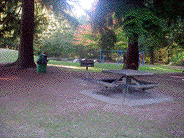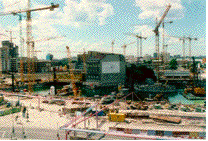site
Site is a word with several different implications. The OED offers the following definitions:
1. a. The situation or position of a place, town, building, etc., esp. with reference to the surrounding district or locality. Occas. without article.
b. In scientific use, a position or location in or on something, esp. one where some activity happens or is done.
2. a. The ground or area upon which a building, town, etc., has been built, or which is set apart for some purpose. Also, in mod. use, a plot, or number of plots, of land intended or suitable for building purposes, and, in wider use, a piece of ground or an area which has been appropriated for some purpose; the scene of a specified activity. Freq. in comb. with the first element indicating the (intended) use of the area as building, caravan, landing, launching, picnic (etc.) site: see these words.
b. transf. The seat of (an industry); the scene of (some condition, etc.).
c. Arch¾ol. A place containing the remains of former human habitation; an excavation.
DRAFT ADDITIONS JUNE 2001
* Computing. a. The location of a computer or computer system, esp. one that runs a web server.
* b. = WEB SITE n.
The above definitions skillfully attach the idea of site to location but never make the two synonymous. Site is never merely an anonymous or universal location or place. Although site is used to describe location, it is often conceived synecdochically, as a part of a larger whole. In addition, it is also associated with an action that occurs at the location of the site. Common usage pairs site with events such as:

a picnic site, a building site, or a landing site:

All of these examples are of a specific space, yet they all also, through their element of action/event, have a temporal aspect. A site, then, incorporates the inevitable connectedness of both time and space. A site is a location, place or position understood in reference to a larger whole and also often times as the location, place, or position of a specified activity.
Also, as noted in the OED definition, site is often used in technical, scientific, or specific fields, such as archaeology, biology, or construction. In these contexts, the emphasis of site is often placed upon the action that is occurring or has occurred at the location. These technical uses again distinguish site from location, lending site a claim to specificity of place and action.

In the late 1960s and early 1970s, artists began to experiment by using a specific environment, or site, as a facet of their works. As art historian James Beardsley notes, these artists were often frustrated by their exclusion from the politics and tightly knit networks of museums and began to reconsider concepts of space, especially space outside of the museum including the outdoors itself (172).
The art works that resulted from this movement (later termed Land Art, Earth Art, Environmental Art or even just installation art) often were inseparable from their environments. The term site was paired with specific, creating site-specific, a word still much in art and architecture discourse today. Installation artists' (including the various branches of land and earth artists) inclusion of site as an important (and often predominant) facet of their work spurred many to reconsider site as a medium itself. Site was seen as both produced and producing.
Robert Smithson, an artist most well known for his sculpture called Spiral Jetty in the Great Salt Lake, explains his use of site as medium: "The unique opaque object refers to itself...It is rigid and blocks space. It is a target. An incorporative work is aerated, part of the material of its place and refers back to itself...So it is that one ceases to consider art in terms of an object." (qtd. in Beardsley 179)
Without the aid of white museum walls to draw boundaries, the viewer is forced to consider site as indistinguishable from content or object.
Because site-specific work often utilizes public sites (graffiti or murals are some examples of the ubiquity of site-specific works) many artists use this exposure and orient their work to interact with the social aspect of a site's context. Jenny Holzer, often labeled as a feminist artist, utilizes site in her work that involves L.E.D. displays such as stock tickers and billboards. She uses these unconventional art sites to install text, short aphorisms, or what she calls "truisms" that are often confusingly social and political, such as "Protect me from what I want" or "Private property creates crime". Her work takes advantage of the social context and the dependence of the site on a larger structure, such as the city.
Yet another example of an artist who engages site and the surrounding social sphere is Ana Medieta. Her works often seem to align neatly with McLuhan's conception of the city as an "even further extension of bodily organs to accommodate the needs of large groups". (123) Mendieta creates performances, documented photographically, of her body literally emerging or blending into a chosen site.

Artists such as these, despite their wide-ranging practices of earth sculptures to manipulating billboards, all make use of site as a medium and the synecdochical relationship of site to physical and social surroundings. The exemplify McLuhan's comment that "no medium has its meaning or existence alone, but only in constant interplay with other media." (26)
It is however, not only artists that are interested in ideas of site. In the late 1970s and early 1980s, the U.S. Department of Defense began developing a navigation system based on satellites called the Global Positioning System, or GPS. The government placed two dozen satellites into orbit, which constantly transmit a signal that can then be received by a user on Earth equipped with a GPS unit. The GPS receiver can then calculate its exact three-dimensional location: latitude, longitude, and altitude by comparing the time the signal was sent from the satellite and the time it was received by the GPS unit. Once the location of a user has been determined, the GPS can calculate a myriad of different data, including velocity, sunset and sunrise, distance to destination, and, because each satellite has an atomic clock, a precise time measurement. In the 1980s, the government made this technology available for civilians. Since then, GPS has grown increasingly popular and has found many uses in every day activities, such as car navigation (Desmond).
With the advent of GPS, our notion of site has become increasingly specific. This technology works day and night, in any kind of weather, any place on earth. Even in the most desolate areas, one could quite easily and quite precisely know both their location and time. In addition to making our expectations incredibly specific, the very process by which the technology of GPS functions connects the aspects of time and space in our notion of site. Site, our location in space, is essentially determined by a time measurement.
Perhaps the technology that one most often connects to the concept of site is not GPS but the ever-growing usage of site in reference to the shortened "website". The OED addendum is certainly deserved: site is a common term in internet discourse. Although Internet: The Complete Reference differentiates between a web page (a single document) and a web site (a collection of linked web pages), site and page are used in normal vernacular speech interchangeably. This distinction, however, is interesting to note as it places the virtual site in yet another part/whole dynamic similar to its tangible counterpart.
A website is a document written in a programming language such as HTML or XHTML. The site is stored on a web server (a computer that stores and transmits files to the internet) and is often linked to several other sites, all accessible through the Internet. Again, the web site is merely one of many pieces of information that connect together to form the World Wide Web.
And although experienced by viewers in the virtual realm, the website, yet again not unlike its tangible architectural counterparts, has an address. This address is known as an URL, or Uniform Resource Locator. This URL address does not specify the location of the web server which hosts the website, but instead acts as the address for the virtual space occupied by the website on the Internet.
Websites too can be seen as a medium. The site is the primary way in which the "surfer" experiences the Internet. Websites are meticulously planned and designed often in terms of real world site planning vocabulary, such as "traffic" or "ease of use". And like the sites of a town zoned for residential or commercial use, websites are owned by a diverse mix of companies, individuals, or governments and contain an endless multitude of topics and information.
Ultimately, sites are often a media layer through which we navigate terrain of installation art, websites, and our own neighborhood. Whether in the virtual world or real world, a site is not simply a place, but rather, a space or location that connects (and often shapes our understanding and experience of) a larger structure and/or activity.
Leah Fosco